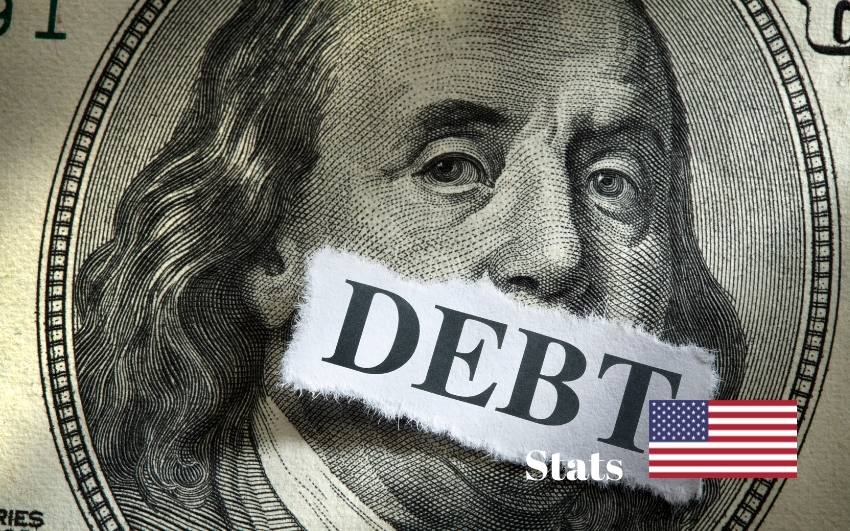On this page

80+ Debt Statistics and Facts in 2023
In 2022, citizens will continue to be burdened by debt, whether positive or negative.
The typical U.S. household’s debt is more than twice its annual income. Many families will likely spend their lifetimes trapped in a debt cycle at that rate.
The consequences of the recent epidemic outbreak are still being evaluated.
Following the devastation caused by this catastrophe, we’ve compiled some eye-opening facts that demonstrate how severe the typical debt issue in the United States has grown across all loan and credit line types.
Our research specialists conducted a comprehensive study of the topic and included debt statistics and facts from only the most trustworthy sources to produce this list.
We believe our material may assist you in looking at debt from a new perspective.
Our debt statistics blog article can help you better understand the current financial situation.
Key Debt Statistics

- The average American has $38,000 in personal debt, excluding home mortgages.
- The average American household owes $15,654 in credit card debt.
- The average student loan debt is $32,731.
- Medical debt is the leading cause of personal bankruptcy in the United States.
- U.S. household debt – including mortgage and non-mortgage obligations – is about $14.3 trillion.
- Household debt is responsible for 75.4% of the United States GDP.
- Credit cards and mortgages make up about two-thirds of all consumer debt in the United States.
- The typical car loan debt in the United States is $19,321.
- The outstanding student debt balance in the United States rose from $46 billion in 2021 to more than $150 billion by 2019.
- Student loans have the highest percentage of delinquent debtors of any loan category.
- According to a 2021 study by Freedom Debt Relief, 14% of U.S. citizens believe they will be in debt for the rest of their lives.
General Debt Statistics

According to IMF statistics, global debt increased by 28 percentage points to 256 percent of GDP in 2020, according to the most recent update of the IMF’s Global Debt Database.
- The percentage increase in debt was 1.1 percent. When you compared it to the 0.3 percent growth from Q3 to Q4 last year, it’s hard not to notice a significant increase. It’s even worse than that: the previous quarter of 2019 is the 22nd consecutive quarter in which U.S. house debt has risen. It stood at $2.3 trillion above its peak before the Great Recession in 2009.
- Household debt statistics show that the proportion was highest in the fourth quarter of 2007, when consumer debt rose to 98.6% of GDP. Historically, consumer debt to GDP has always been less than 50%. In 1952, consumer debt accounted for just 23.8% of US GDP when it was at its historical high. From then until now, the typical was 58.35%.
- Repaying the average household debt has become more challenging by the growing cost of living, which has risen 30% over 13 years compared to a 28% rise in incomes. Since 2003, medical costs have gone up 57%, whereas food and housing expenses have increased by around one-third.
- Of the homes that had debt, the average debt per household in America was $137,063 (including mortgages, loans, and revolving credit) in 2018.
- While it is true that paying off credit card debt may be difficult, any specialist would tell you that it is as essential a habit as brushing your teeth. Households with revolving debt pay $1,162 per year in credit card interest alone. Some families find it difficult to reduce their debt since their spending and interest far exceed their income. Saving money statistics are outright scary.
- According to the most recent statistics, the proportion of people with no debt is frighteningly low; only 23% of individuals stated they had no obligation, which is 4 percentage points less than in 2017.
- The federal government owes $1.27 trillion in U.S. dollars.
- This figure includes federal student loans provided under the Federal Direct Loan Program and the Perkins Loan Program.
- Strictly speaking, forbearance is deferring payments on your loan for some time with the lender’s permission. Of course, interest continues to accrue during this period. Debt holders are more inclined to agree to this arrangement because of the extra interest and because foreclosure usually becomes worse for them.
- According to census data from two years ago, there are currently 113 million Americans with a vehicle loan obligation. This is only behind the number of credit card debtors, who owe $176 billion:
- A debtor who fails to make their payments on time is called a “delinquent.”
- The lowest rate of credit card delinquency is 2.49 percent among debtors. According to a survey from Visa and TransUnion, the average amount owed per person in the United States is $5,800. This number was calculated from a pool of borrowers with 176 million individuals.
- The probability of credit card debt rises with having children: Children in families are 51 percent more likely to have credit card debt than those who are not.
- Household debt data reveal that households with children pay a greater yearly credit card interest rate than $1,356 compared to $1,141.
- 43% of credit card users are debtors who carry a balance on their cards, known as revolvers.
- There are many different ways to utilize your credit card. The ABA classifies three sorts of credit card users: revolvers, transactors, and dormant.
- Transactors use their credit cards to pay for things but make careful monthly payments. They use credit cards to improve their scores while getting cashback bonuses and avoiding interest. According to U.S. debt statistics, 31.9 percent of all credit card users are transactors. Dormant, who don’t use their cards often, make up 24% of the population.
- Revolvers are the most problematic debtors, owing money and enduring the sting of interest rates. The fewer revolvers there are, the less healthy the debt economy is. Over the previous three years, their numbers didn’t change much; their proportion of all credit card users is 44.1%.
Top 5 Causes For Debt
Many factors can lead to debt, but some causes are more common than others. Here are the five most frequent reasons people find themselves in debt:
- Unforeseen Expenses: Unexpected medical bills, car repairs, or home emergencies can quickly send your finances into a tailspin.
- Job Loss: A loss of income can make it challenging to keep up with your monthly debt payments.
- Divorce: The financial stress of a divorce can often lead to debt.
- Poor Money Management: Overspending and not keeping track of your finances can put you in a difficult financial situation.
- Student Loans: The rising cost of education can often lead to student loan debt.
While debt can be challenging to manage, it’s important to remember that you’re not alone.
Many resources and organizations can help you get out of debt. And with a little bit of effort, you can make a plan to get your finances back on track.
Credit Card Debt By Age
Generation X owes more on their credit cards than any other generation, with an average balance of $7,236. This is over $1,000 higher than the next closest generation (baby boomers), with an average balance of $6,230.
$2,312 is the average credit card debt for Generation Zers–the lowest of any age group. Since young adults have lower incomes on average, their credit limit is also usually lower. This at least helps with avoiding excessive credit card debt.
- Regarding average credit card debt by age, Generation X and baby boomers rank at the top with more than $7,500 per person.
- This shouldn’t come as a surprise. After all, these generations have more dependents and a more significant disposable income than previous ones. Millennials have an average debt of $4,315 on their credit cards, while those born after 1997 owe $2,047.
- According to a recent poll, 24% of millennials enjoy exploring possibilities and potential outcomes. On the other hand, financial planning is seen as “exciting and inspiring” by only 16%.
- The millennial generation is more conscious than previous generations of the need to plan for the future in an era of recession and ecological disaster. It has also made them more concerned about their debts, with 78 percent reporting that they are “kept apart by the pressure” of handling their financial futures and present obligations.
- Despite this, debt data reveal that millennials have the same outstanding debt as Generation X and baby boomers: around $36,000.
- The median amount owed by baby boomers in non-mortgage debt is $25,187.
- The name “baby boomer” was given to the generation that grew between 1946 and 1964 during the postwar baby boom. Many are still in debt as they enter or settle into retirement.
American Debt Statistics

The New York Fed’s latest Household Debt and Credit survey results show that Americans owe $890 billion in credit card debt as of Q2 2022. That’s up from $790 billion in Q2 2021 and $870 billion in Q2 2019. With the cost of energy, food, and healthcare all continuing to rise, many people may be looking for a new way to save money. For example, this could be due to inflation if you use an American Express credit card instead of a debit card on your phone (or even a regular credit card).
- The average American household has $137,063 in debt. This includes mortgage, auto, credit card, and student loans. ( CNBC )
- The average amount of credit card debt per American household is $6,194. ( NerdWallet )
- The average interest rate on credit card debt is 16.97%. ( Federal Reserve
- The typical American credit card debt is $6,194.
- Two out of 10 Americans in debt say they allocate more than 50% of their monthly income to debt reduction.
- According to a recent American Express Spend Survey, only 17% of us have between $5,000 and 20,000 in savings. Twice as many people are in debt by that amount.
- According to the latest data, total consumer debt statistics in the United States is $4.2 trillion as of Q1 2020, not including mortgages.
- The average debt statistics per person in America is $26,621.
- The total revolving U.S. debt statistics stood at a little over $1 trillion in February 2020.
- According to a new study, the average adult in the United States of America has $3,299 in revolving debt. Revolving debt is when you borrow and pay back different monthly amounts. Variable interest rates are used in revolving debt. If you borrow $400 one month but repay only $50, you may reborrow (or revolve) the remaining $50 right away. That’s it? That’s because your credit card utilizes the revolving debt technique.
- According to credit card debt statistics and studies, many Americans are still ignorant of the risks of using a credit card and not paying their bills on time. Every year, the amount of revolving debt in the United States has grown, from $888 billion in 2014 to over $1 trillion by 2020.
- More than half of Americans said their 2019 financial goal would be debt reduction at the end of last year. The overall average American debt rose by approximately $1,000 throughout 2018.
- The typical debt in the United States is $26,621. It’s no surprise that more than 65% of personal loans are used to pay down or consolidate debt. Refinancing your credit card debts is not advised if the amount owed exceeds half of your yearly income. Experts advise against taking out a loan to refinance your credit card debt if it totals more than half of your annual earnings.
- The average credit card debt in Iowa is the lowest of all states. This figure is 29% less than the national average: $4,774. Wisconsin, Mississippi, Kentucky, and West Virginia are the following four states in line.
- Alaska, on the other hand, seems misplaced. The largest state is an outlier, with a typical credit card debt of $8,026.
- 37% of Americans’ income is spent on dining, entertainment, leisure, travel, and hobbies.
- U.S. citizens are accustomed to spending their disposable income on themselves. According to consumer data, while 36% of income that does not cover expenses and food is allocated to debt reduction, 15% goes toward nightlife and dining.
- Most American consumer debt (about 66 percent) comprises credit cards and mortgages.
- The total non-revolving debt statistics of U.S. citizens is now $3.12 trillion.
- Non-revolving debts are generally paid off in fixed monthly installments. On the other hand, bank loans are typically settled in fixed installments. Consumers have the option of selecting between a fixed and variable interest rate.
- The amount of non-revolving debt in the United States has increased by over 20% since 2015, from $2.5 trillion to $3.1 trillion by 2020.
- Household debt statistics are now worth 75.4% of the US GDP.
U.S. Consumer Debt Statistics
Consumer debt statistics 2022: The average consumer in the United States has $90,460 in total debt. This encompasses all forms of debt including mortgages, student loans, auto loans, credit cards, and any other type of loan. The average American carries $137 in credit card debt. 66% of respondents in a 2019 study said they carry credit card debt from month to month.
- 33% of consumer debt is owed to credit cards, a percentage that has increased by 6% since last year. Car loans make up 9%, whereas student loans account for about 8% of overall debt.
- Personal loan balances have been declining as a result of the Great Recession. In 2007, it hit a high of $72 billion before falling to $46.4 billion in 2011. On the other hand, personal loans have been growing at breakneck speed since the economy began to recover, and consumers have regained confidence in paying off their debts. They are now the most rapidly expanding consumer debt service.
- The total amount of money owed, considering the borrowed funds and accrued interest. The condition is getting progressively worse; consumer debt at the end of 2019 was more than $4 trillion, up from just under $3.4 trillion in Q1 2016.
- The U.S. consumer debt market is dominated by depository institutions, savings institutions, and commercial banks. These lenders account for about 40% of the overall consumer debt ($1.6 trillion) in the United States.
Student Loan Debt Statistics
- There are 42 million people in America with student loan debt and 4.83 million who have not kept up their payments.
- As you might guess, student loans are one of the most common sources of personal debt among millennials. Student loans account for 37% of overall debt among persons aged 18 to 24.
- If all student loan debtors who continue making payments for a year were to put them on hold for 12 months, they would incur $5.72 billion in interest charges alone.
- In the United States, 2.7 million student-loan debtors applied for forbearance in Q1 2019, according to government data. According to previous statistics, the average balance of these debts is $46,679.
- The percentage of delinquent debtors for student loans is the highest of all loan types: 11.5%.
American Attitudes Toward Being in Debt
- Most people in the United States (87%) feel that financial security and stability are essential for a positive outlook on life.
- While money may not be the key to happiness, it may cause much suffering in the United States. Half of all Americans report that their financial situation makes them nervous, insecure, and afraid. A fifth feels terrible “all the time” due to their debt.
- 15% of Americans believe they’ll be in debt for the rest of their lives, according to a FICO survey.
- Furthermore, 13% of Americans think they will be in debt for the rest of their lives. The average household owes $38,000 in consumer debts (not including mortgages), and 40% of people believe they will need to work until they are 70 years old.
- Americans are more anxious about debt than in the previous decade. More than half of Americans (55%) report feeling worried about debt at least once a month, and 35% feel guilty for similar reasons.
Canada Debt Statistics
- In the second quarter of 2019, Canada’s total consumer debt – including mortgage and non-mortgage debt – was $2.25 trillion.
- Canada’s debt totaled $60,000 per capita, compared to roughly $26,621 per person in the United States. Non-mortgage loans and consumer credit totals were $782.9 billion, while mortgage debt was only over $1.47 trillion. That’s about $59,000 in Canadian debt for every person compared to approximately $26,621 in U.S. debt per capita. To preserve accuracy: 60,000 Canadian dollars is roughly equivalent to $46,000 US money.
Personal Debt Statistics
- Debt management is the most common reason for taking a personal loan (61%).
- The number of Americans in default on their P2P personal loans has nearly tripled since 2011, from $46 billion to $156 billion as of the third quarter of this year.
- As of February 2014, about 788,000 American households (0.63% of all U.S. households) used payday loans, with an average loan size of $392.The typical American household carries $15,654 in credit card debt. More than 60% of Americans have more obligations than they have savings.
International Debt Statistics
High debt levels can lead to financial instability and make it difficult for countries to respond to economic shocks. This can have severe consequences for global growth and prosperity.
- According to the World Bank, global debt reached a record high of $182 trillion in the third quarter of 2019, up from $169 trillion in Q2. This is equivalent to 232% of the world’s GDP.
- The United States has the largest share of this debt at $23.3 trillion, followed by China with $16.6 trillion and Japan with $9.1 trillion.
- Other countries in the top 10 include Germany ($6.8 trillion), Italy ($2.6 trillion), and the United Kingdom ($2.4 trillion).
- Emerging market economies have seen the most significant increase in debt since 2007, with their debt-to-GDP ratio rising from 36% to 53%.
Conclusion
Debt is a part of life for most Americans, and it doesn’t appear to be going away anytime soon. The best way to handle debt is to be proactive about it, understand the terms and conditions of your loans, and make payments on time. Some organizations can help you get back on track if you’re struggling with debt.
Faq
How much debt does the average person have?
As of 2020, the average American consumer had about $38,000 in personal debt, not including home mortgages. This number has been on the rise in recent years and will likely continue to increase.
What is the most common debt?
The most common type of debt in the United States is credit card debt. As of 2020, the average American household owed about $5,000 to credit card companies. Other common types of debt include student loans, auto loans, and home mortgages.
How many Americans are in debt?
As of 2020, about 70% of Americans were in debt. This includes both individuals and households.
How much debt does the average American have?
The average American consumer had about $38,000 in personal debt, not including home mortgages, as of 2020. This number has been on the rise in recent years, and
How much debt is the average American in 2022?
As of 2022, the average American consumer is expected to have about $40,000 in personal debt. This includes all types of debt, such as credit cards, student loans, and auto loans. The amount of debt an individual has can vary greatly depending on age, income, and other factors.
Related:
Statistics for this article on Debt statistics were collected from the following sources:

Petri Maatta is a mindset coach and neuroscience-focused author with 15 years of experience in personal transformation and success psychology. After seven years of business failures, he discovered the power of manifestation through a Fortune 500 mentor. Now, he shares neuroscience-backed strategies through DreamMaker membership, helping others transform their businesses and lives on their own terms.
Read My Story here.
Share This Story, Choose Your Platform!
You want to manifest a new car, but you’re wondering: Does this really work? Here’s
Many smart individuals are often linked with having a high IQ. However, according to emotional
According to online dating statistics over 90% of people believe in love at first sight,




